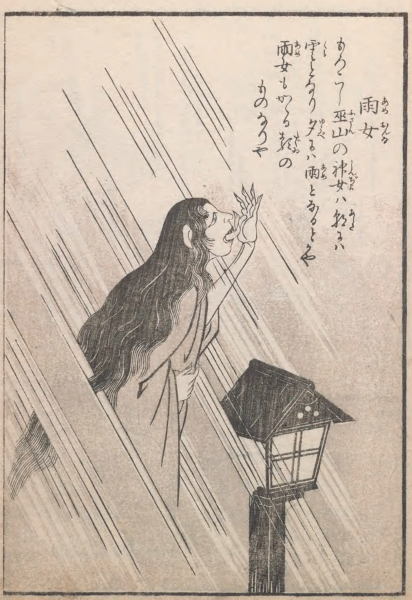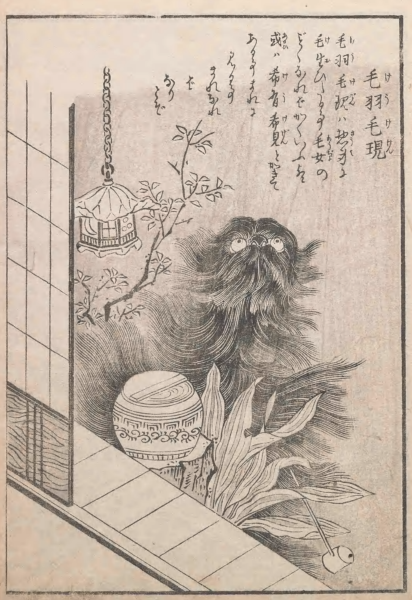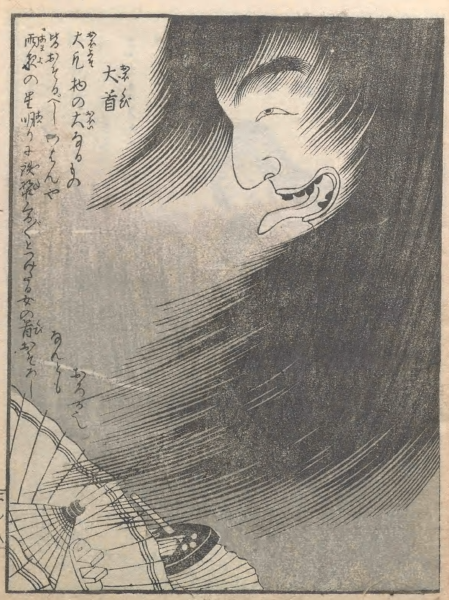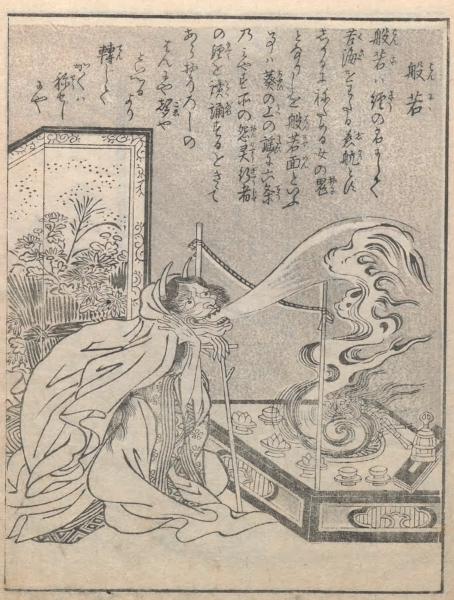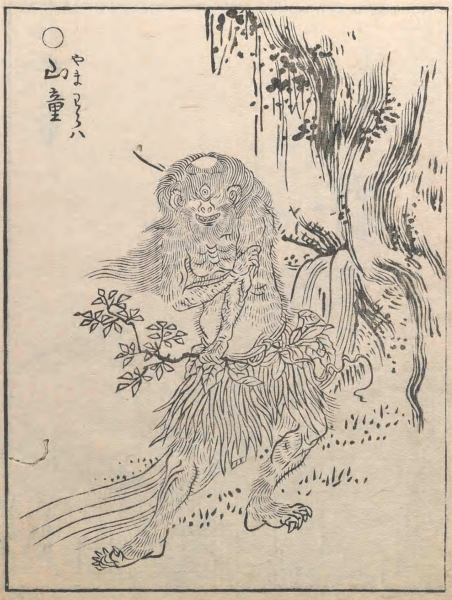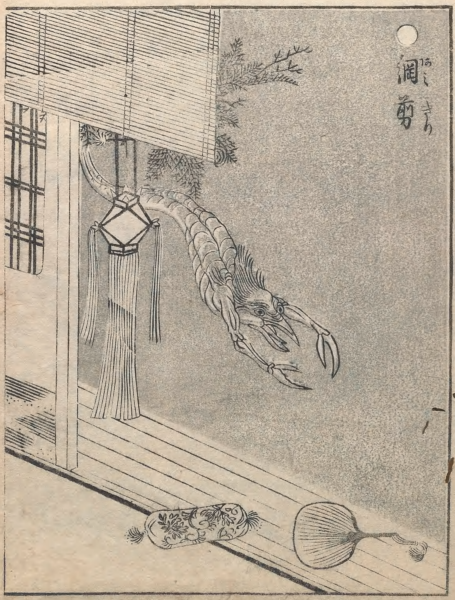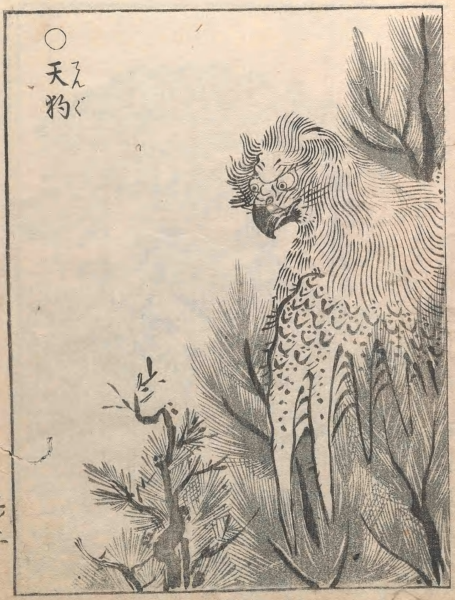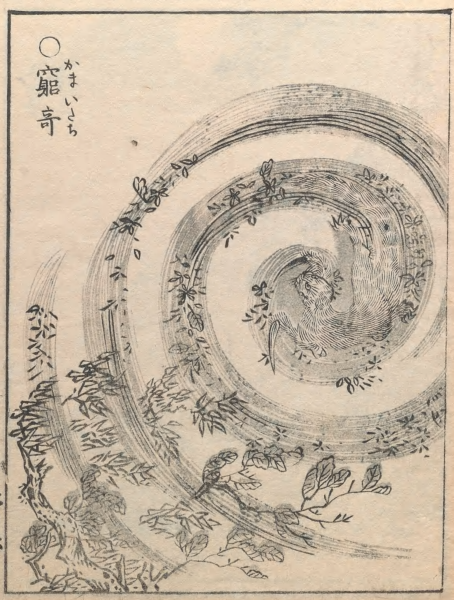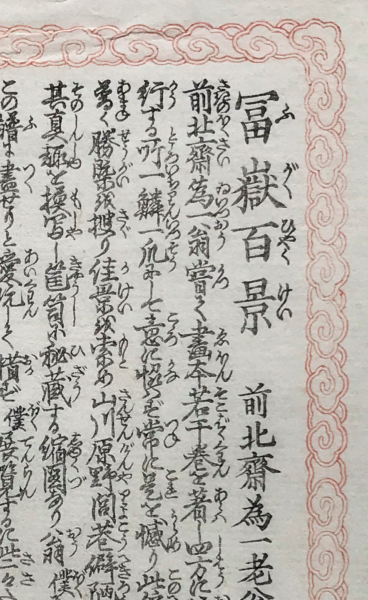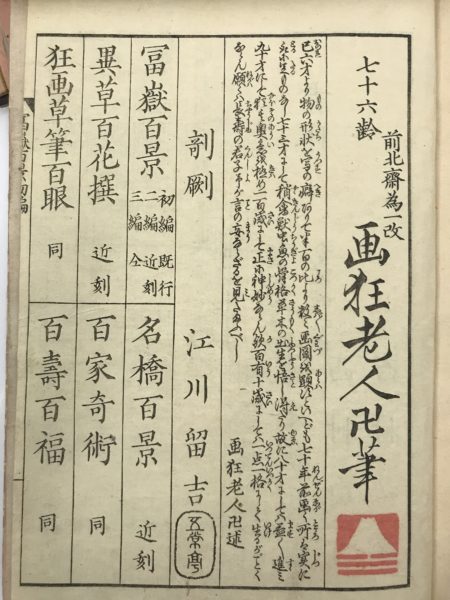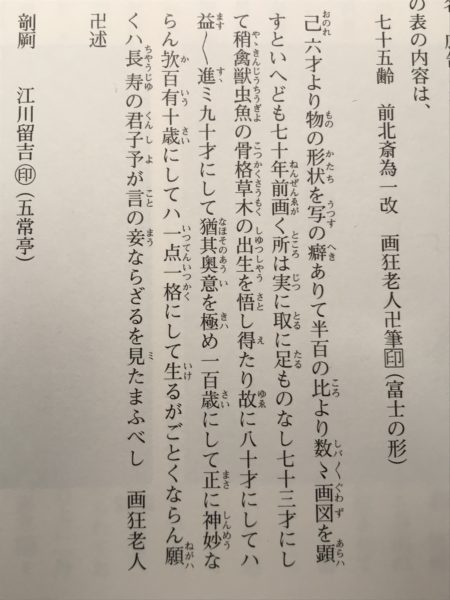In Part 2 of my Brief History of Prints of Actors, I raised the question ‘how designers of prints in much of the eighteenth century could possibly make a living,’ as well as suggesting that ‘it is only from the 1760s that Torii Kiyomitsu 鳥居清満 and Torii Kiyotsune 鳥居清経 can finally make a living by illustrating 71 and 200 popular novels respectively, in addition to the prints they designed, a totally new development of the time.’ As this may raise some eyebrows or even the question whether this is really correct, it may be good to have a closer look at the development of popular fiction at the time.
Going by Yamazaki Fumoto’s Nihon shōsetsu nenpyō 山崎麓『日本小説年表附総目録』(近代日本文學大系25) of 1929 – certainly not an infallible source, but absolutely sufficient for an overview and an adequate understanding of the developments – we find for the 1750s a total of 219 various kinds of popular fiction that go by the overall term of kusazōshi 草双紙, the largest portion, some 41%, being of the then popular kurohon 黒本 genre. For only 26 of these 219 titles the name of the illustrator is indicated. When you might consider this surprising, you’ll probably be even more amazed to learn that an author is only mentioned for 79 of these publications, or 36% – and later on, we’ll see why. Indeed, the 1750s and especially the 1760s is the period when names of writers are only just beginning to be mentioned, as also the late Nakano Mitsutoshi 中野三敏 (1935-2019) correctly remarked – but please forgive, I don’t remember where exactly. In the 1760s kurohon it would mostly be Kansuidō Jōa 観水堂丈阿 1686-1770 act 1752-70 whose name is mostly given, probably as he was then the most popular author.
And what about the Kyōhō Proclamation 享保布令 of XI/1722, you may wonder, as this required all publications to clearly indicate the real names of both author and publisher. Absolutely correct, but the common practice in Japan is that it prefers to have rules just in case there is some good occasion or need to apply them. And that moment would eventually and even most incidentally come with the Kansei Regulations of V/1790 (see below), and later again with more consequences with the Tenpō Reforms, Tenpō no kaikaku 天保の改革 of XII/1838 (Feb/1839), and mostly in Edo and to a much lesser extent in the Kansai Region, although they witnessed serious problems and unrest from the peasant uprising led by Ōshio Heihachirō 1793-1837 大塩平八郎 (cf also Kabuki nenpyō 7:345 歌舞伎年表).
Going back to the popular novels, in the 1760s, we see a considerable increase, numbering a total of 494 titles, with for only 198 the illustrator being mentioned. The majority, some 57% is still of the kurohon genre. And in the 1770s the number still increases to 529 titles, with for 262 of these an illustrator given. As I remarked earlier, this is where we finally see the beginnings of the ukiyo or ‘floating world’ culture. No less than 259 of these titles, some 56%, are of the kibyōshi 黄表紙 genre that by general agreement starts in 1775 with Koikawa Harumachi’s 恋川春町 1744-1789 Professor Clink-Clink’s Dream of Glory, Kinkin sensei eiga no yume『金々先生栄花夢』 illustrated by himself, and published by Urokogataya Magobei 鱗形屋孫兵衛. Ever since, novels of the kibyōshi 黄表紙 genre would continue to be a great success, until they were replaced by novels of both the yomihon 読本 and the gōkanmono 合巻本 genres from about 1805. Indeed, in the 1780s we can see some 653 new titles of the kibyōshi genre alone, an average annual production of 65 titles, with the names of the illustrators given for 475 of them, and their writers now for 529 titles. Later still, in the 1790s, their number stays steady and we can cite some 479 titles.
It is thanks to this ever increasing market of various genres of popular literature that those Edo publishers who chose to just focus on local production, the so-called jihon toiya 地本問屋, could develop. Their audience is the more than 1.3 million inhabitants of the metropolis Edo, undoubtedly also finding an avid readership among the 600.000 samurai directly serving the shogun. In fact, to get back to the writers of popular fiction, Koikawa Harumachi 恋川春町 act 1773-89 who is recognized as the author of the first kibyōshi novel, was a vassal of Matsudaira Hōshū 松平房州, the daimyō of Suruga 駿河侯 (as Kyokutei Bakin 1767-1848 in his recollections, Recent Books and the Party of Edo Writers, Kinsei mono no hon Edo sakusha burui. 曲亭馬琴『近世物の本江戸作者部類』1831, in the Kimura Miyogo 木村三四吾 edition of Tokyo: Yagi Shoten, 1988, p 31 tells us). We shall soon see why exactly this position enabled him to become a prolific writer of fiction (14 kibyōshi in the 1770s and 16 in the 1780s). Taking lessons with Toriyama Sekien 鳥山石燕 1713-1788 — whom we know as the teacher of Kitagawa Utamaro 喜多川歌麿 — he would also make the illustrations for most of his writings himself, as well as illustrating those by other authors. Hōseidō Kisanji 朋誠堂喜三二 1735-1813, act 1777-91 (9 kibyōshi in the 1770s and 24 in the 1780s) enjoyed a similar position as a vassal of Satake Ukeichō 佐竹右京兆, the Kubota daimyō 久保田侯 (Bakin 30).
As for Ichiba Tsūshō 市場通笑 1737-1812 act 1779-95 (8 kibyōshi in the 1770s, 96 in the 1780s, and 4 in the 1790s) he appears to have just written novels in his leisure time, otherwise making a living as a mounter of paintings, hyōgushi 表具師 (Bakin 32). Somewhat comparable is the position of Shiba Zenkō 芝全交 1750-1793 act 1780-93 (27 kibyōshi in the 1780s and 16 in the 1790s), writing popular fiction next to his official position of kyōgen actor 狂言師, a kind of comic nō performances such as were especially popular in daimyō courts (Bakin 32). And Nansenshō Somando 南仙笑楚満人 act 1783-99 (9 kibyōshi in the 1780s and 19 in the 1790s) made a living as a maker of sword sheaths, 鞘師 (Bakin 33).
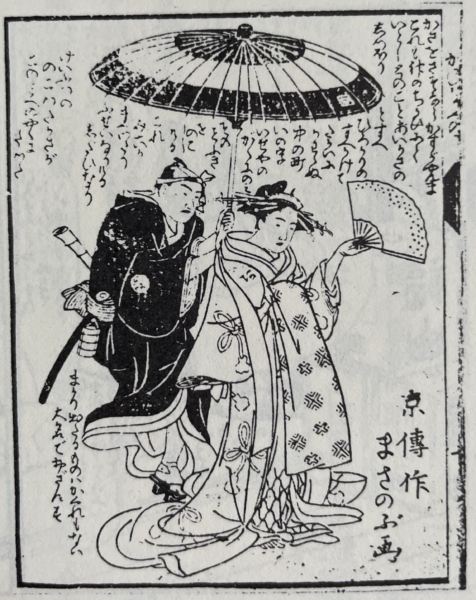
Here we should realize that their writing popular novels would not necessarily yield them some extra income. As we know from Bakin’s recollections ([Bakin 37] act as a writer of 28 kibyōshi in the years 1793-98), it was only around 1795 or 1796 that the publishers Tsutaya Jūsaburō 蔦屋重三朗 and Tsuruya Kiemon 鶴屋喜衛門 decided to at least pay their star writers Santō Kyōden 山東京伝 1761-1816 (act as a writer of kibyōshi in the years 1780-99, 39 in the 1780s and 61 in the 1790s) and himself, as their novels generally sold in editions of 10 thousand copies or more (mind you, a best seller is presently defined as a book selling to 1% of the population, which would be 13.000 copies in the case of Edo). But this was not automatically applied to most other writers. They might at best hope to get some newly published novels or woodblock prints as a New Year present, or maybe being invited to some dinner party in the second or third month at the Yoshiwara — as had been the custom until then.
This explains how and why samurai writers such as Harumachi and Kisanji could afford writing novels in their spare time, enjoying a regular income anyway. Or also, for example as we saw, Ichiba Tsūshō, Shiba Zenkō and Nansenshō Somando, each of them next to their regular metier. Bakin also tells us that many aspiring writers had to pay a publisher the so-called nyūgin 入銀, a sum to have their writings printed and published, which probably explains the numerous names of authors just identified with one or just a very small number of novels in the last decades of the eighteenth century.
However convincing this may seem, it must also be said that Mizuno Minoru in his Santō Kyōden nenpukō. Tokyo: Perikansha, 1991, p 42 (水野稔『山東京伝年譜稿』東京:ぺりかん社) asserts that Kyōden received an advance of one gold ryō and five silver monme 金一兩銀五匁 in VII/1790 for three sharebon 洒落本 that Tsutaya Jūsaburō would publish in I/1791. This is quite well-documented as this would eventually as a result of the Kansei Regulations of V/1790, in III/1791 lead to Kyōden being fined to 50 days in handcuffs, Tsutaya as the publisher seeing half of his possessions confiscated, and the members of the Guild who had okayed their publication being exiled from Edo. There is probably some reason not to rely too much on Bakin’s memory.
Bakin also informs us that Koikawa Sukimachi 恋川好町 1751-1829, a pupil of Koikawa Harumachi, saw some success as a writer of popular novels (15 in the years 1785-94), but couldn’t really make a living (Bakin 35). He then gave up and started training as a writer of kyōka 狂歌 poems. Becoming a judge of these poems and charging one ryō silver 一銀両for his correcting a hundred poems, he finally could make a living. We now know him best as one of the greatest kyōka poets of the early nineteenth century, Kyōkadō Magao 狂歌堂真顔.
As for the background of Iba Kashō 伊庭可笑 38 kibyōshi in the years 1779-86, we have no idea and Bakin doesn’t mention him. A minor writer such as Shitchin Manpō 七珍万宝1758-1831 could afford to do this as an aside to his sweet shop 上菓子店 by Shiba Zōjōji 芝増上寺, or more precisely at Sakurada Kubochō 桜田久保町 as Kyōka jinmei jisho 『狂歌人名辞書』 has it (Bakin 38). Bakin specifies that he was a pupil of Manzōtei 万象亭writing fiction from late Tenmei until mid-Kansei. Indeed, I found him active in the years 1787-95 with 21 kibyōshi novels to his name. Later he took the name of Manzōtei II and gave up writing fiction, becoming a renowned kyōka poet, active until his death in 1831.
Sakuragawa Jihinari 櫻川慈悲成 1762-1833? presents a somewhat similar case. Bakin informs us that he was running a small shop of Imari porcelains and metal ornaments 今利焼などの陶器を鬻ぐ小店 and that he had but little success with his writings — 47 kibyōshi in the years 1789-99 — and even still displaying no talent when he turned to writing kyōka poems (Bakin 39). Here I would suggest that he deserves some more praise for what he accomplished, for example, among others, he made some very nice surimono designs himself and initiated a most impressive series of annual New Year’s surimono, and was good or even close friends with Utagawa Toyohiro 歌川豊広, Ichikawa Danjūrō VII 七世市川團十郎, and Utagawa Hiroshige 歌川広重.
In conclusion we may say that writing fiction was, at least in the last decades of the eighteenth century, rather a vocation for those who could afford it and would have some leisure time. When we may believe Bakin, it was only from the middle of the 1790s that both he and Kyōden were being paid for their writings, though there is some evidence that Kyōden was even paid a considerable advance sum already in 1790. We may, on the other hand, assume that illustrators, or at least most of them, were considered to be ‘painters,’ eshi 絵師, and thus craftsmen who were naturally being paid for their work. And this, as I stated at the beginning, is how Torii Kiyomitsu and Kiyotsune could make a living as illustrators in the exploding market of popular novels, with a readership that expected a text that would be enlightened by explanatory illustrations.
Most likely, Koikawa Harumachi who, as we saw, also made the illustrations to most of his writings, was not considered an eshi, even though he studied with Sekien, being a samurai anyway, and thus he was not being paid for his illustrations. It seems that Santō Kyōden studied painting with Kitao Shigemasa 北尾重政 1739-1819 from about 1775, aged 14, and made his debut in 1778 as the artist Kitao Masanobu 北尾政演, illustrating the novel Ohana Hanshichi – Kaichō riyaku no mekuriai『お花半七―開帳利益遊合』 as well as the cover for a jōruribon 浄瑠璃本, illustrating another four novels as well as again a jōruribon in 1779, and in 1780 eleven kibyōshi, one sharebon 洒落本 novel and at least six prints of actors in role in the hosoban 細版 format. And then, maybe sufficiently convinced of some promising future, it is also in 1780 that he starts writing novels, illustrated by himself and published by Tsuruya Kiemon, the Yonemanju no hajimari『米饅頭始』in two vols and signed ‘written and ills by Kitao Masanobu’ 北尾政演画作, and Musume katakiuchi kokyō no nishiki 『娘敵討古郷錦』in three vols and signed ‘written for fun by Kyōden’ 京伝戯作. From then, he would always continue to illustrate most of his writings himself. And, as we learned from Bakin, he would be paid for his writing from about 1795 or 1796. We then have no idea whether it was his lifestyle, needing some more income, that made him run a shop of tobacco pouches and such smoking utensils from IV/1794.
